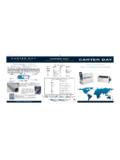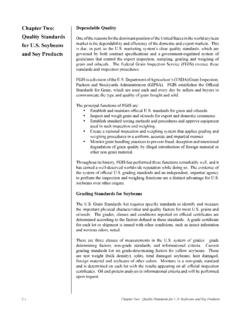Transcription of GUIDELINES - EFNARC
1 EUROPEAN SPECIFICATION FOR SPRAYED CONCRETE. GUIDELINES . FOR SPECIFIERS AND CONTRACTORS. Association House, 99 West Street, Farnham, Surrey, GU9 7EN, United Kingdom tel: +44(0)1252 739147 Fax: +44(0)1252 739140. EFNARC was founded in March 1989 as the European federation of national trade associations representing producers and applicators of specialist building products. Membership has since widened and now includes many of the major European companies who have no national trade association to represent their interests either at national or European level. EFNARC members are active throughout all the countries of Europe, more particularly in Belgium, France, Italy, Germany, Norway, Spain, Sweden, Switzerland, and the United Kingdom.
2 EFNARC main activities at European level and at CEN Technical committees are in flooring, the protection and repair of concrete, in soft ground tunnelling and in sprayed concrete. It provides a common voice for the industry to make known its position and view to the European Commission departments dealing with the CPD, CEN Technical Committees and other Groups dealing with European harmonisation of Specifications, Standards, Certification and CE making relevant to our industry. In each product area it operates through specialist Technical Committees which have been responsible for producing Specifications and GUIDELINES which have become recognised as essential reference documents by specifiers, contractors and material suppliers throughout Europe and beyond.
3 Acknowledgements EFNARC wishes to acknowledge gratefully all the contributions and comments made by users of the Sprayed Concrete Specification published in 1996 and to the subsequent extensive work undertaken by members of its Sprayed Concrete Technical Committee. Although care has been taken to ensure, to the best of our knowledge that all data and information contained herein is accurate to the extent that it relates to either matters of fact or accepted practice or matters of opinion at the time of publication, EFNARC assumes no responsibility for any errors in or misrepresentation of such data and/or information or any loss or damage arising from or related to its use.
4 All rights reserved. No part of this publication may be reproduced, stored in a retrieval system or transmitted, in any form or by any means, electronic, mechanical, recording or otherwise, without prior permission of EFNARC . ISBN 0 9522483 6 0 1999 EFNARC . i CONTENTS. FOREWORD .. 1. G2. REFERENCES .. 1. G4. CONSTITUENT 1. 2. Aggregates .. 2. Mixing water .. 2. Steel reinforcement .. 2. Fibres .. 2. Admixtures .. 4. Additions .. 5. Curing agents .. 6. G5. REQUIREMENTS FOR CONCRETE COMPOSITION .. 6. General .. 6. Cement .. 6. Additions .. 7. Aggregates .. 7. Admixtures .. 8. Fibres .. 9. 9. Working 9. G6. REQUIREMENTS FOR 9. General .. 9. Chloride content.
5 10. Alkali content .. 10. Requirements related to environment conditions .. 10. G7. MIX 11. General .. 11. Designed mixes .. 11. Prescribed mixes .. 11. Combined mix design .. 11. G8. EXECUTION OF 12. Preparatory 12. Spraying operations .. 13. Equipment .. 15. Application of wet-mix sprayed concrete for rock support .. 16. Scaffolding .. 17. G9. REQUIREMENTS FOR FINAL 18. Compressive 18. Flexural strength .. 19. Toughness properties .. 19. Modulus of 19. Bond strength .. 19. Fibre 19. 20. Frost resistance .. 20. ii G10. TEST METHODS .. 20. Test panels and samples .. 20. Compressive strength and density .. 21. Flexural strength and residual 21.
6 Energy absorption class (plate test).. 22. Modulus of 22. Bond strength .. 23. 23. Frost resistance .. 24. Determination of fibre content .. 24. G11. QUALITY 24. General .. 24. Preconstruction 24. Quality 24. G12. HEALTH AND SAFETY .. 25. GUIDELINES TO APPENDIX 1 - Admixtures for Sprayed Concrete: Definitions, Specifications, Requirements, Reference Concrete Mixes and Test 28. ANNEX A Determination of energy absorption capacity of slab specimens .. 30. iii FOREWORD. The EFNARC European Specification for Sprayed Concrete was published in 1996 following a draft that had been produced three years earlier. During the intervening period, over 1000 copies of the draft version had been circulated and the comments received were taken into account in the final published specification.
7 The Specification has since been used widely and has rapidly become a standard reference document in the industry around the world. The Specification sets out the essential requirements for a successful sprayed concrete installation. Subsequently the section of the Specification on the Execution of Spraying has been amplified and issued separately. The GUIDELINES presented here provide a commentary on the Specification by giving an explanation of the requirements. To aid cross-referencing between these GUIDELINES and the Specification, the clause numbers are generally those of the Specification to which the GUIDELINES relate: those in italics are sub- divisions of the GUIDELINES (eg ).
8 G2 REFERENCES. The following CEN test methods represent the latest guidance relevant to sprayed concrete and supersede the list given in Section 2 of the EFNARC specification: ISO 6784 Concrete - Determination of static modulus of elasticity in compression (1982). prEN 12356 Testing concrete - Shape, dimensions and other requirements for test specimens and moulds prEN 12359 Testing concrete - Determination of flexural strength of test specimens prEN 12363 Testing concrete - Determination of density of hardened concrete prEN 12364 Testing concrete - Determination of depth of water penetration under pressure prEN 12378 Testing concrete - Sampling fresh concrete prEN 12379 Testing concrete - Making and curing specimens for strength tests prEN 12382 Testing concrete - Determination of consistency - slump test prEN 12390 Testing concrete - Determination of compressive strength - specification for compression testing machines prEN 12394
9 Testing concrete - Determination of compressive strength of test specimens prEN 12399 Testing concrete - Determination of pull-out force prEN 12504 Testing concrete - Cored samples - taking, examining and testing in compression prEN 1542 Products and system for the protection and repair of concrete structures - Test methods - Pull-off test prEN 13057 Products and system for the protection and repair of concrete structures - Test methods - Determination of Capillary water absorption Additional references to published work: Austin S. A. and Robins P. J. (eds) 'Sprayed Concrete: properties, design and installation', Whittles Publishing, Latheronwheel, UK (ISBN 1-870325-01-X) and McGraw Hill, USA (ISBN 0-07-057148-1), 1995.
10 McLeish A., 'Standard tests for repair materials and coatings for concrete', CIRIA Technical Note 139, Construction Industry Research and Information Association, London, 1993. Opsahl , 'Steel fibre reinforced for rock support', BML Report , Division of Building Materials, The Norwegian Institute of Technology, Trondheim, September 1983. th Melbye T., 'Sprayed concrete for rock support', 4 edition, January 1996. G4 CONSTITUENT MATERIALS. The constituent materials should be selected to satisfy technical and health and safety criteria. Strength requirements as well as any other requirements concerning mechanical characteristics, thickness, shape, finishing, etc.



